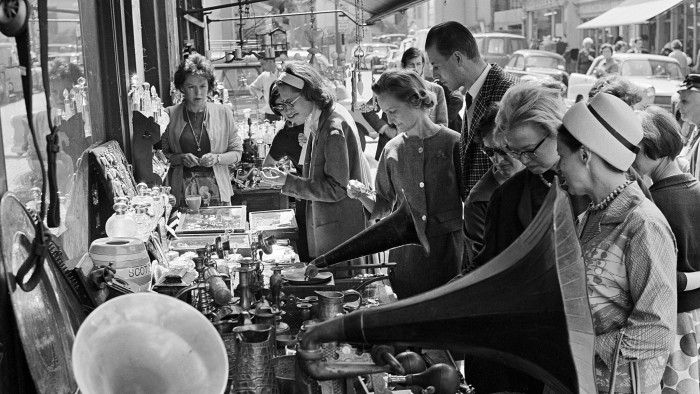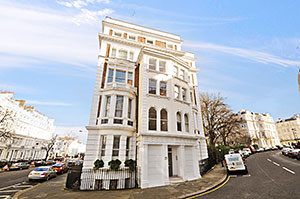Market forces: the changing face of London’s Portobello Road

Simply sign up to the Life & Arts myFT Digest -- delivered directly to your inbox.
Portobello Road in west London is home to one of the most famous antiques markets in the world. Every Friday and Saturday 100,000 visitors stroll past a mile-long strip of multicoloured Victorian terraces, attracted by the bohemian atmosphere and the shops and street stalls selling not just antiques, but fruit and vegetables, jewellery, bric-a-brac, vintage clothes and fabrics.
Yet, despite the fame and the footfall, many believe the market is under threat. Rising rents and falling takings have forced some local stalls and boutiques to close and make way for flagship stores from international brands such as Kurt Geiger and American Apparel, or tourist shops peddlling “I heart London” souvenirs.
“Thanks to the film Notting Hill, Portobello Road has become a tourist destination and that’s not great news for traders,” says author Blanche Girouard, whose recent book Portobello Voices features interviews with stall-owners, shopkeepers and local characters, many of whom testify to feeling driven out by the changes.
Writer and film director Richard Curtis set much of his 1999 hit romcom Notting Hill in Portobello, where it served as the location for the home and bookshop of his main character, Will Thacker, played by Hugh Grant. Today, tourists are more likely to hunt for landmarks seen in the movie – such as Thacker’s blue front door – than for bargains on the market.
Tourist revenues couldn’t save Clara Curry’s independent shoe shop, housed at 142 Portobello Road, the site of Thacker’s “Travel Book Co.” in the film. Curry told the Evening Standard in February that rising rents forced her to move on after six years.
“It’s a cartel between the developers and the local council,” says Marion Gettleson, an antiques trader who has been on Portobello Road for more than 35 years. She is convinced that the Saturday footfall figures are used to increase rents, which in turn drive up local business rates. It seems to be affecting housing too.

“There are generations of people who grew up round here [who] can’t recognise the housing market any longer,” she says. “The dead hand of the developer has had this area by the throat for the past 25 years.”
Estate agents Douglas & Gordon estimate the average price of a three-bedroom family home in Notting Hill has increased by 120 per cent since 2009, but Portobello Road has hardly been leading the charge.
“The area has been changing for a long time, but Portobello Road has actually stayed relatively static,” says independent property buyer Charles McDowell, who specialises in prime central London purchases. “Prices might have increased around 15 per cent over the past few years – so a family home would cost about £3.5m – but in a road like Dawson Place [a few streets away] a family home would set you back £15m.”
Peter Mackie, senior partner at buying agents Property Vision, has lived just off Portobello Road for the past 15 years. “It’s much less edgy now,” he says, “there are a lot fewer bohemians and a lot more people wearing dark glasses and pushing buggies around.”

Because of the street noise and the difficulty getting in and out of Portobello Road on market days, typical buyers today often tend to be young professionals, often without families. Estate agent Domus Nova is selling a three-bedroom apartment above a shop on Portobello Road for £1.47m. On nearby Stanley Crescent, Douglas & Gordon is selling a more family-friendly, three-bedroom flat for £2.95m, converted from a former single-family Victorian house.
The appeal of Portobello has attracted volume developers too. Catalyst Housing has knocked down the 1960s Wornington Green Estate at the north end of the road, and rebranded it “Portobello Square”.
Having opened its doors to the first residents last year, Portobello Square will see a total of 1,000 new units being built over 10 years, with 538 – the number of units in the council-controlled Wornington Green – set aside as affordable housing.

The next tranche of apartments are set to go on sale this spring, with market value units priced at £580,000 for a one-bedroom flat to £1.4m for a three-bedroom property.
Emma Dent Coad, Labour councillor for the Royal Borough of Kensington and Chelsea, is critical of the quality of the work carried out in the affordable housing block. “The building leaks like a sieve,” she says. “I’ve seen quality control problems in every flat I’ve been in.”
In response, Catalyst says it has received positive feedback from many of its residents. “Some people have reported problems – many of them very minor in nature – but we are addressing these,” says a spokesperson. “We are redeveloping what is a very constrained urban site and, unfortunately, it’s inevitable that in such a complex project there will be some issues that need addressing.”
Dent Coad has been an outspoken critic of the development since planning permission was granted by the Conservative-led council in 2010. “It’s the first postwar redevelopment in the borough,” she says, “and was a completely unnecessary step for them to take.”
Tensions between locals and the council are at fever pitch, according to local resident Ivo Dawnay, who thinks more should be done to protect the independent atmosphere of Portobello Road. A case in point, he says, is the failure to prevent Lipka’s antiques arcade – which once housed 80 independent dealers – being transformed into the flagship store of fashion brand All Saints in 2009.
“The council were powerless to stop it,” says Tim Ahern, the councillor responsible for the area’s markets. “An arcade is classed as a shop and there are no powers to prevent it being turned into a single store.”
The council says it sympathises with Dawnay’s concerns, and has budgeted more than £130,000 a year to spend on the market’s upkeep and promotion. Yet offering business rate relief to independent shops over big chains would be a step too far, says Ahern. “Then the question would be, ‘Why is the taxpayer subsidising a shop that wants to sell, say brushes, over one that sells clothes?’ We would be hammered in the courts.”

Charlie Trier, who has been selling vintage clothes at Portobello market for the past 16 years, argues that councils are not the best organisations to run markets.
“I think the moment a council gets involved with a market they tend to make a pig’s ear of it,” he says. For Trier, who also has a stall in Oxford which he says costs half the rent and makes twice the profit, the answer is much simpler. “I think that Portobello has had its heyday . . . Over the last three years it has been in decline and slowly [it has] been going out of fashion.”
It is a view that writer Girouard can sympathise with. “Partly the area is under threat from market forces, but partly it’s down to people’s buying habits. I spoke to a fruit and veg seller who said the people who live opposite his stall are getting their fruit delivered by Ocado,” she says.
Roarie Scarisbrick, of Property Vision, thinks the new developments will hardly provide the market with a shot in the arm, regardless of how closely they align their brand with Portobello. “Nobody is buying in [Portobello Square] because they want to buy their avocados from the fruit and veg stalls,” he says. “They’re buying there for the address and the atmosphere, not for the market and certainly not for antiques.”
So has the die been cast? Not according to Girouard. “Portobello is not a charity case,” she says. “When I was researching the book I spent a lot of time on the market, and the quality of the goods I found was amazing. I think if we can just alert people to the fact that you can still get wonderful things here and meet wonderful, fascinating people, then the market has a chance. It’s not too late yet.”
——————————————-
Buying guide

● The market sells fruit and vegetables from Monday to Thursday, fashion and new goods on Friday and antiques on Saturday. Traffic congestion on Saturdays can be terrible
● Tube trains from Notting Hill Gate take five minutes to Paddington and 16 minutes to the City
● The crime rate is fairly average for London, at 15.5 crimes per 1,000 people in December 2013, but the monthly figure is about double that for August when the area hosts the Notting Hill Carnival
● Well-performing schools include Notting Hill prep, a local independent school that is popular with locals but gaining admission is difficult
What you can buy for . . .
£500,000 A one-bedroom former council flat on Portobello Road
£2m A decent-sized, two-bedroom flat on Ledbury Road
£10m A family home with access to private residents’ gardens in Elgin Crescent
Comments